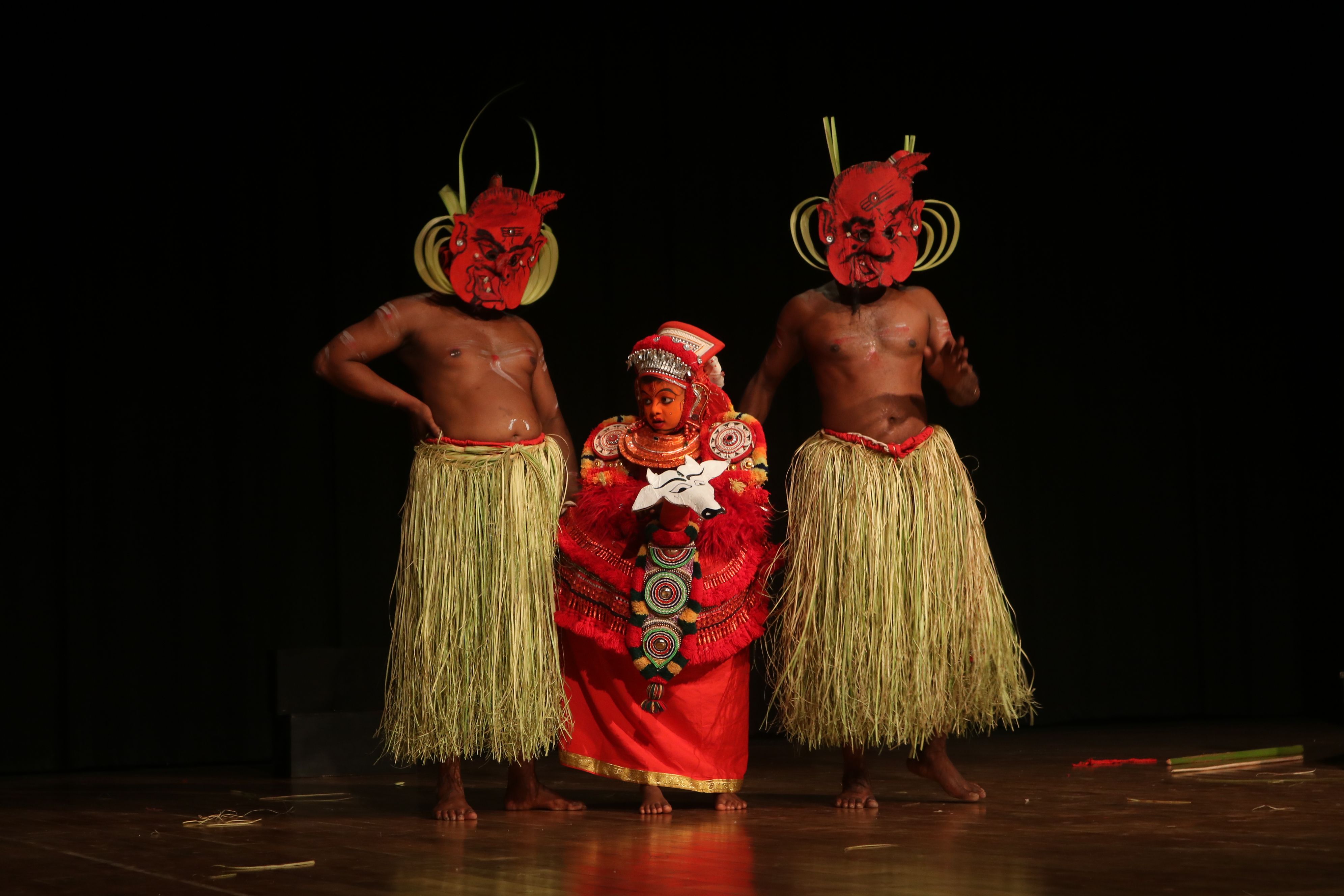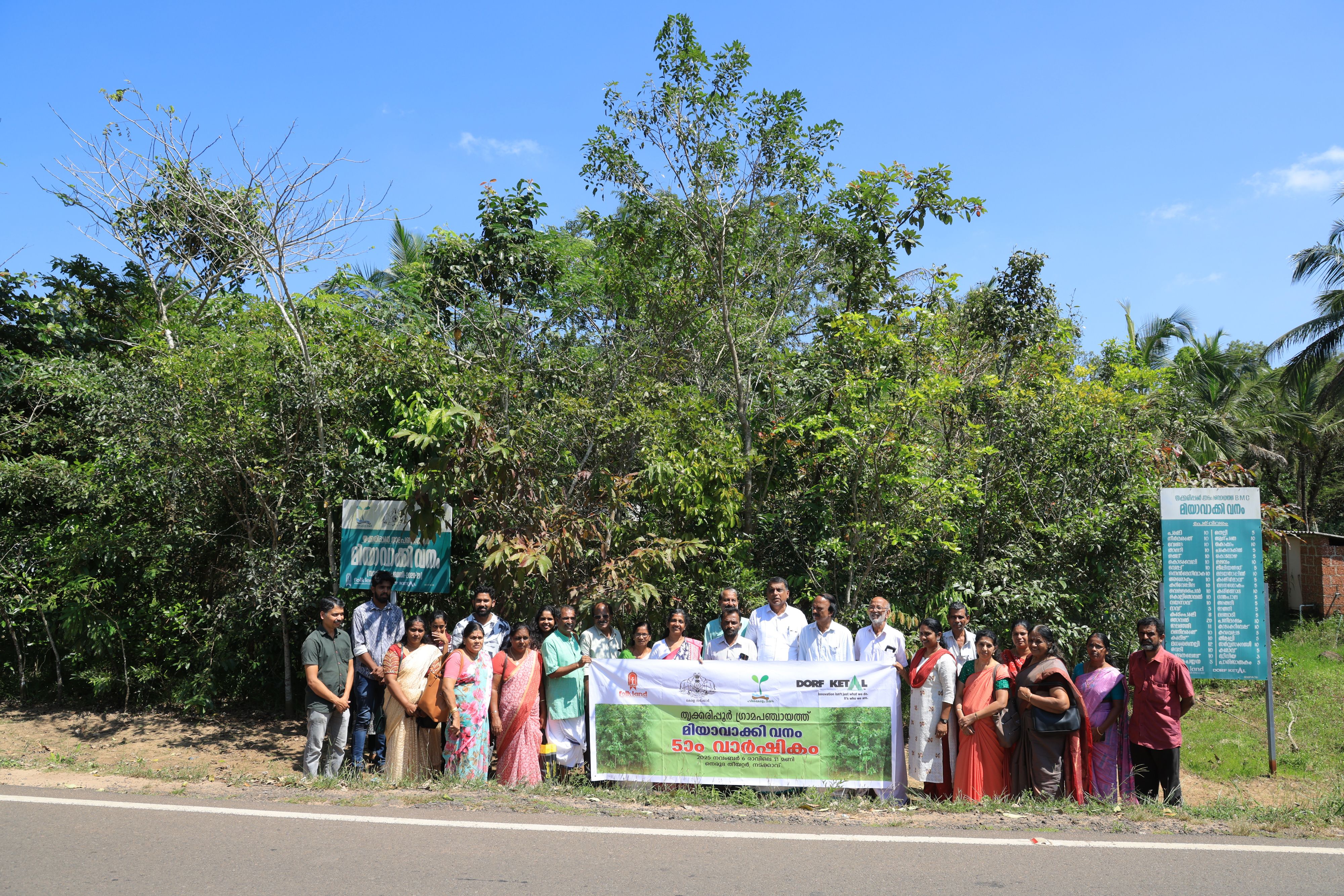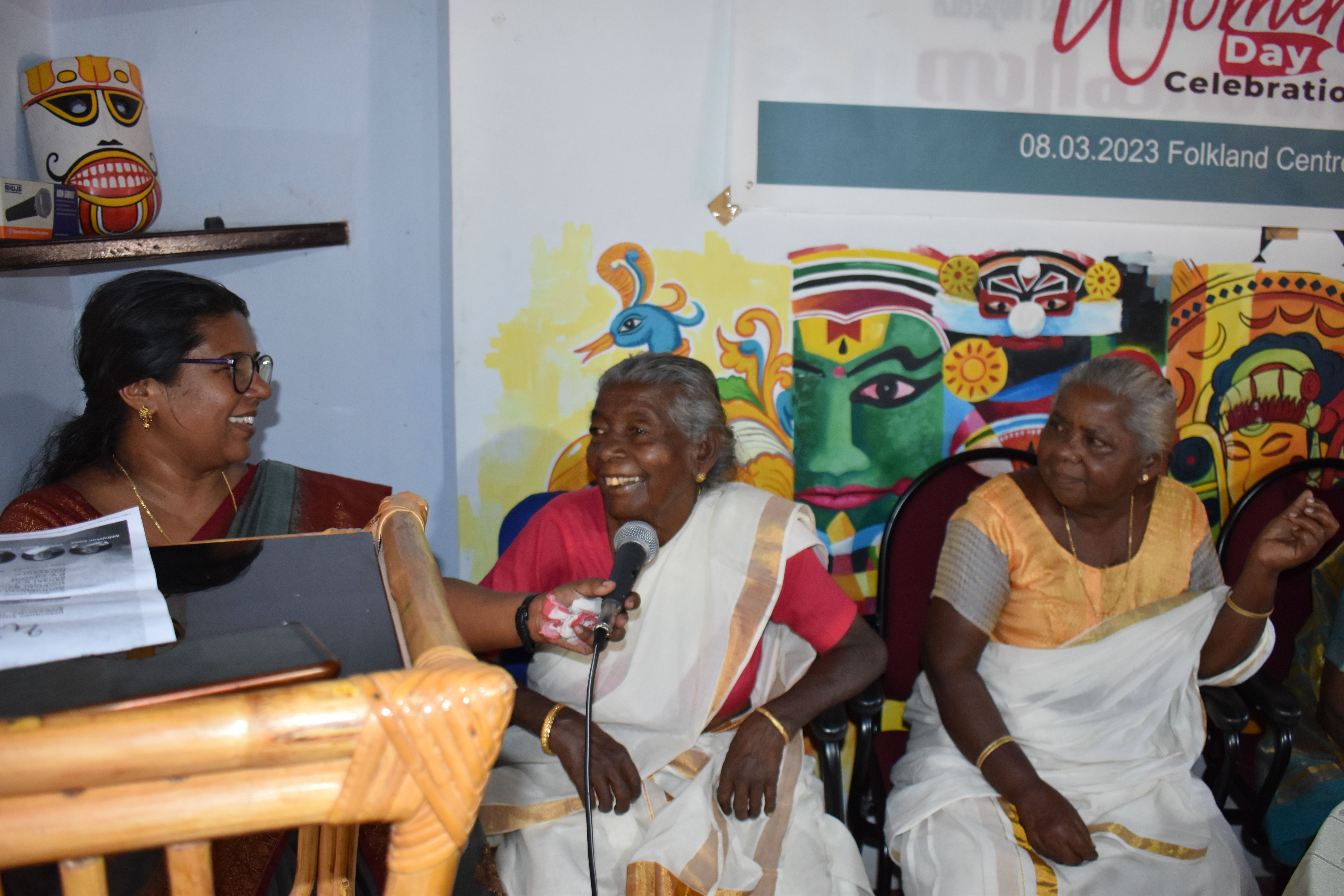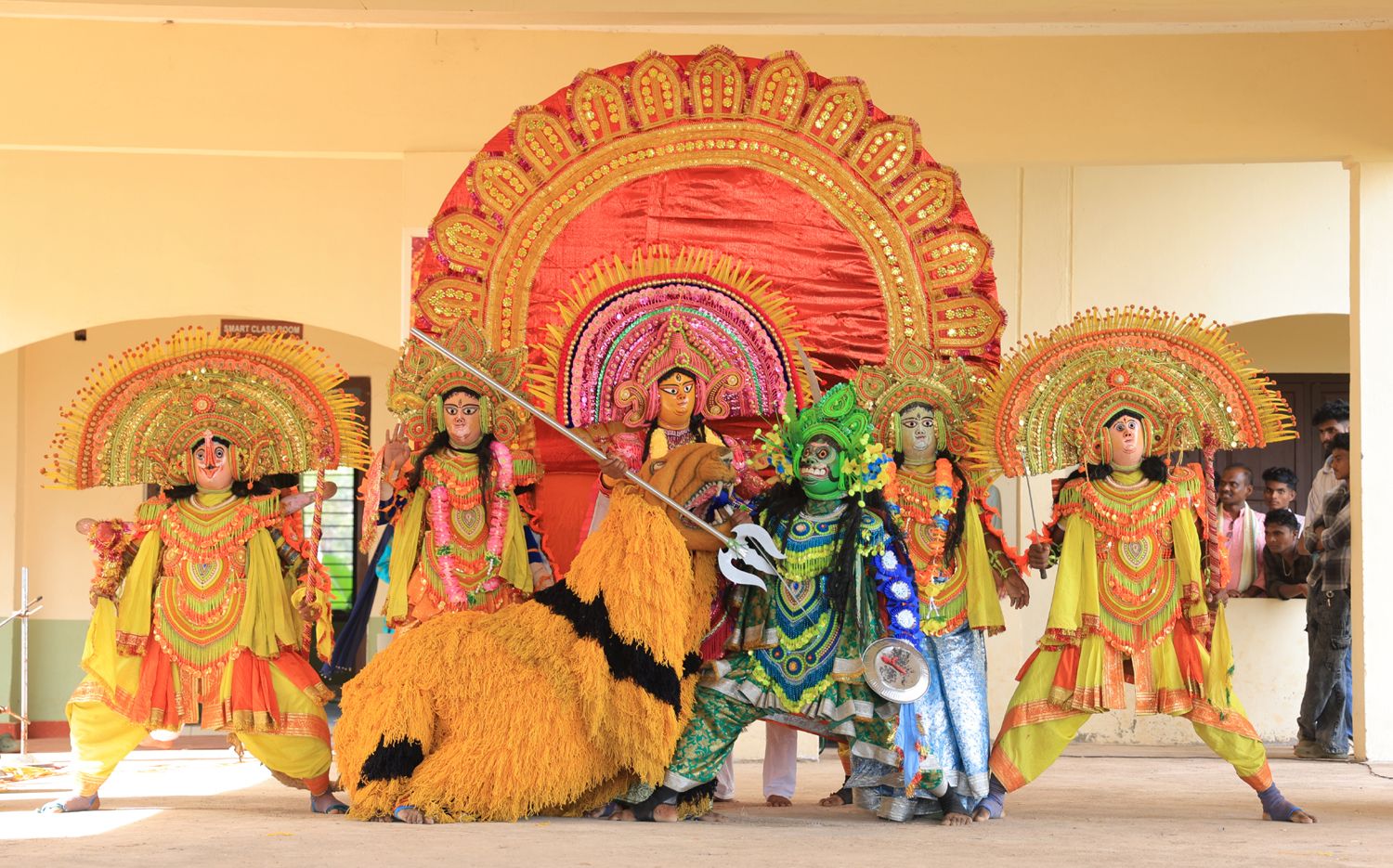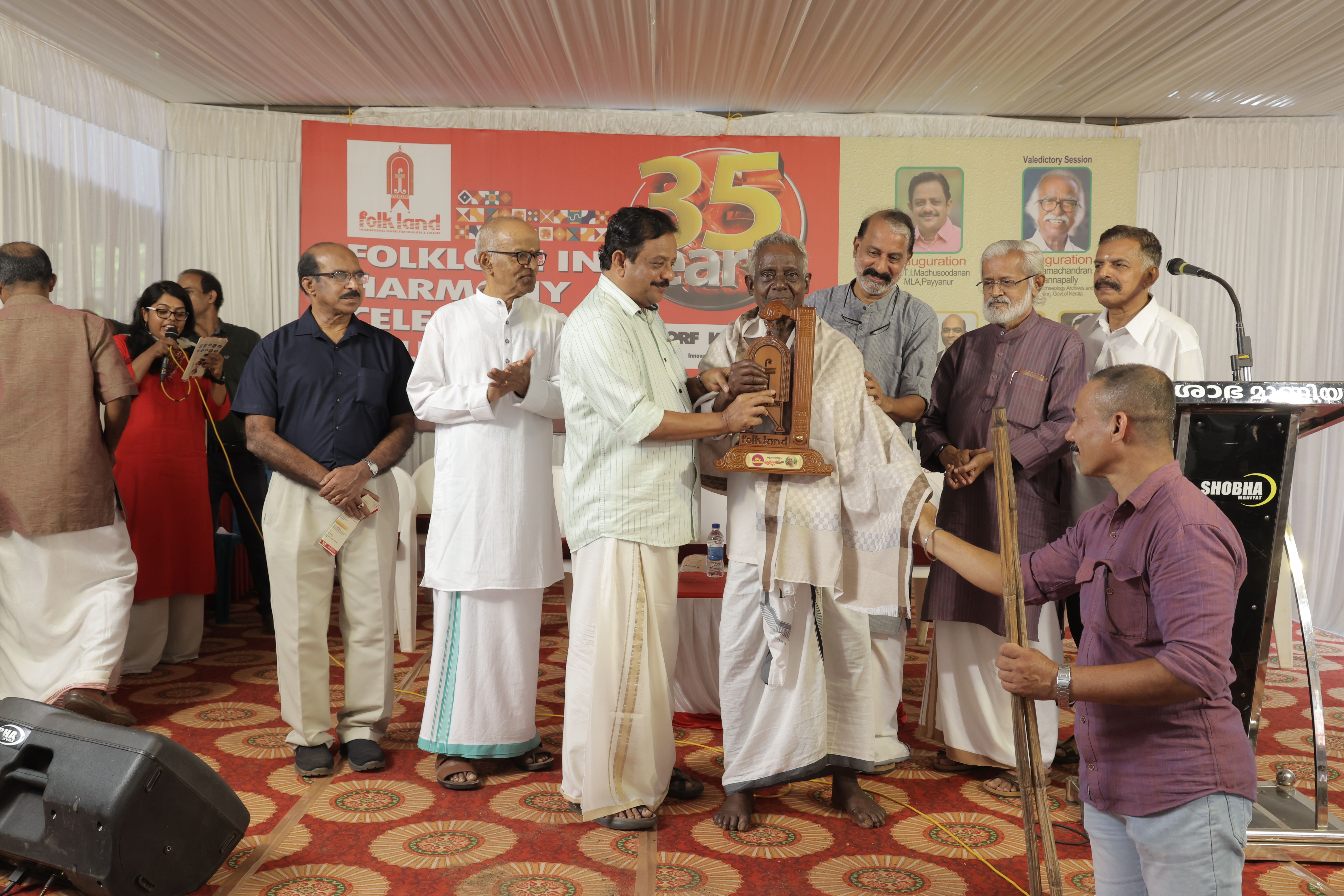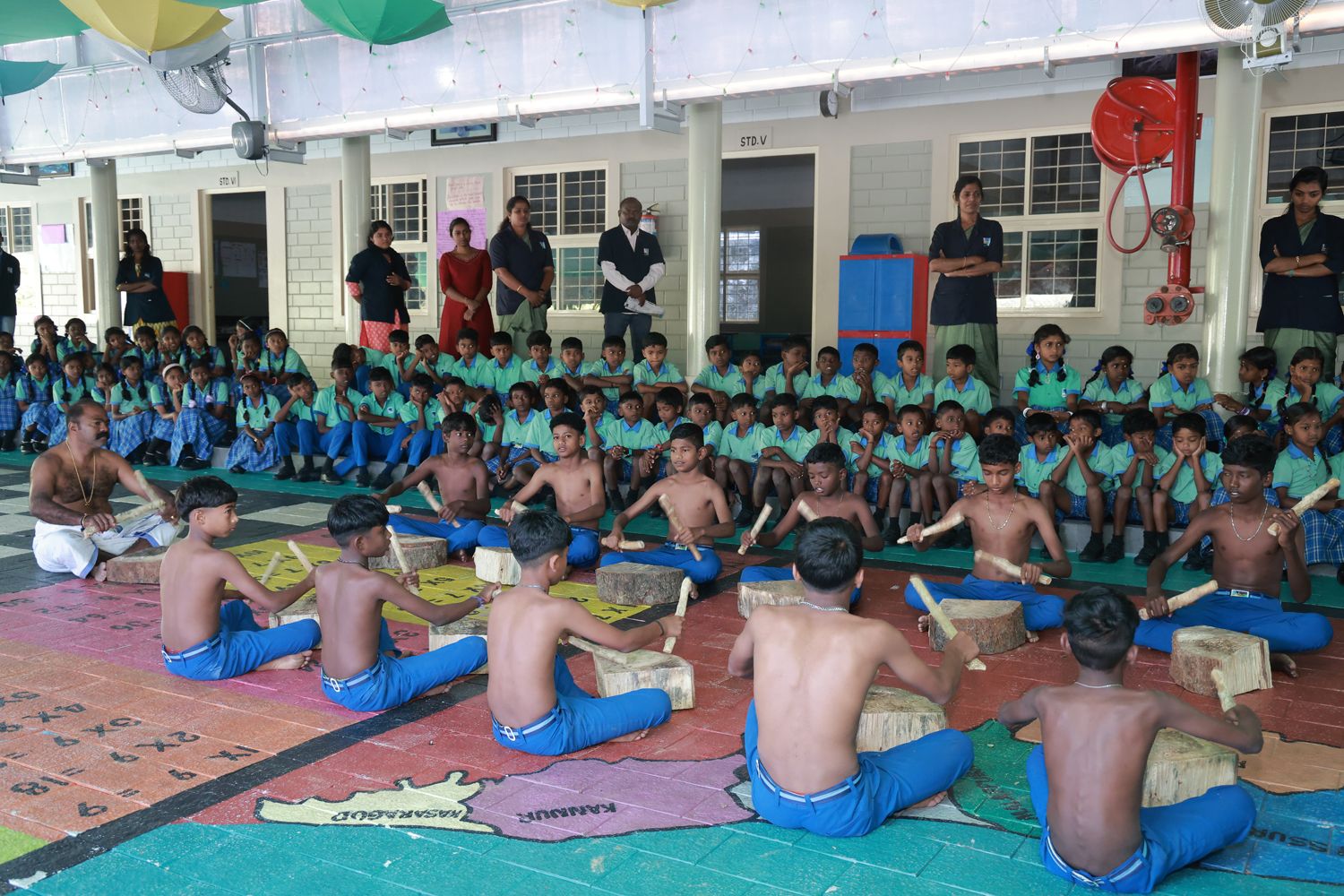Kerala's folklore reflects both practical and symbolic representations of bulls, showcasing their profound role in the region's agricultural, ritualistic, and cultural life. Bulls have historically been indispensable to Kerala's agrarian communities, aiding in plowing fields, transporting goods, and processing crops, thus embodying strength, fertility, and vitality. Beyond their practical utility, bulls hold deep religious significance, particularly as the vahana (vehicle) of Lord Shiva, symbolizing divine power and protection. This reverence is evident in Kerala’s temple festivals, such as the vela celebrations in Thrissur and Palakkad, where elaborately decorated bull effigies are carried in processions as sacred symbols, central to collective worship practices. In tribal traditions, rituals like Eruthukali, observed during the Tulam month (October), highlight the bull's cultural prominence. During Eruthukali, a bull effigy, accompanied by drummers and masked performers, visits households to ward off evil spirits and bless families with prosperity. Households express devotion and gratitude by offering rice, money, and clothes to the effigy, reinforcing the bull's symbolic association with divine blessings and agricultural abundance. Through such rituals and festivals, the bull transcends its utilitarian role, emerging as a powerful cultural and spiritual symbol deeply woven into Kerala's traditions. The Symbolic and Practical Role of Bulls in Kerala’s Folklore Kerala, a land celebrated for its rich cultural diversity and deeply rooted traditions, has always held animals in great reverence within its folklore and rituals. Among these, the bull stands as a powerful symbol of strength, fertility, and vitality, occupying a prominent position in both practical and spiritual spheres. Bulls are deeply interwoven into the agricultural and ritualistic lives of Keralites, embodying both utility and divinity. Bulls in Agricultural Traditions Historically, bulls have been indispensable to Kerala’s agrarian communities. They were central to plowing fields, transporting goods, and processing crops, becoming symbols of prosperity and agricultural productivity. For generations, these animals were the backbone of rural economies, facilitating farming and daily life in an era that relied heavily on manual labor. This deep-rooted reliance fostered a profound respect for the bull, which transcended its practical role and entered Kerala’s folklore as a divine and cultural icon. Symbolism in Religious and Cultural Practices Beyond their agricultural significance, bulls carry immense symbolic importance in Kerala’s spiritual and cultural traditions. The bull is closely associated with Lord Shiva, where Nandi, the revered bull, serves as both the vahana (vehicle) and devotee of the deity. This sacred symbolism highlights the bull’s divine role as a protector, guide, and emblem of unwavering strength. Temple festivals across Kerala celebrate this symbolism, particularly through the grand Vela festivals in Thrissur and Palakkad districts. Here, bulls—often represented through ornate effigies—take center stage in ceremonial processions. These effigies are elaborately decorated, treated with reverence, and carried as part of the collective worship practices that bring communities together. The presence of the bull effigy signifies strength, protection, and divine blessings, reinforcing its spiritual importance. Tribal Customs: The Eruthukali Ritual The tribal traditions of Kerala also showcase the cultural significance of bulls, particularly in rituals like Eruthukali, performed during the Malayalam month of Tulam (October). In this ritual, a bull effigy, accompanied by drummers and masked figures, visits houses across tribal communities and other houses in the village. The ritual is believed to propitiate the gods, ensure good harvests, and ward off evil spirits. The visiting effigy is welcomed with offerings of rice, clothes, and money, symbolizing gratitude and devotion to the divine role of the bull. Eruthukali serves as a powerful example of the bull’s symbolic connection to fertility, protection, and prosperity in Kerala’s tribal folklore. It reflects the community’s belief in the bull’s ability to bring blessings and safeguard the household from misfortune. Bulls as Cultural Icons Whether in agrarian traditions, temple festivals, or tribal rituals, the bull continues to hold a prominent position in Kerala’s folklore. It symbolizes strength, vitality, and divine grace, embodying the harmonious coexistence of practical and spiritual dimensions. The reverence shown to bulls reflects Kerala’s enduring cultural values, where animals are not just part of daily life but are revered as sacred symbols integral to both worship and livelihood. The Cultural and Agricultural Significance of Bulls in Kerala Kerala's rich cultural heritage is deeply intertwined with its agricultural traditions, where bulls have historically played a central role. As a predominantly paddy-growing state, Kerala's agricultural practices depended heavily on bulls for ploughing fields, transporting manure and crops, and threshing harvested spikes. Before the advent of tractors and modern machinery, bulls were integral to the lives of farmers, forming an inseparable link between productivity and cultural practices. Bulls in Agricultural Life In traditional Kerala, bulls were the backbone of agriculture, performing a range of essential tasks that sustained farming communities. Bulls were primarily used for ploughing the fields in preparation for sowing, an activity that symbolized the beginning of the agricultural cycle. Farmers also relied on bulls to transport manure from their homes to the fields and to carry paddy seedlings and harvested crops. Male cattle were specifically chosen for agricultural tasks such as ploughing, transporting goods, and threshing spikes, while female cattle were valued for their milk production. In northern Kerala, an age-old practice known as “Okkal” showcased the pivotal role of bulls in threshing paddy.
The Okkal Tradition Okkal was a labor-intensive and culturally rich activity where bulls were used to thresh paddy spikes in large quantities. The process began with the preparation of the ground, where a layer of cow dung was applied to ensure smoothness. Paddy spikes were then spread across the prepared surface, and a pair of bulls—tied to a central stick—were led in circular motions to crush and separate the grains. What set Okkal apart was the festive atmosphere surrounding it. Threshing often took place at night, accompanied by folk songs, clapping, and drumbeats to motivate both workers and bulls. The traditional drum, “Tudi,” was used to create rhythmic beats, and agricultural workers often engaged in lively folk dances, transforming the activity into a cultural celebration. Among Kerala's tribal communities, the Mavilan tribe of Kasargod district actively participated in the Okkal tradition. The last recorded Okkal festival was conducted in 2003 under the auspices of Folkland International Centre for Folklore and Culture and the Kerala Agricultural University at the Kodiyankundu ancestral house in Malom village, Kasargod. This event marked the culmination of an era, preserving the memory of a practice that connected agriculture, community, and culture. The Decline of Cattle Population The advent of mechanized farming and tractors led to a decline in the dependence on bulls for agricultural purposes. As a result, Kerala’s cattle population has significantly decreased. According to the 2019 livestock census, India’s total cattle population stands at 193.46 million, whereas Kerala accounts for only 1,341,996. This decline underscores the shift from traditional practices to modern farming methods, leading to the gradual disappearance of age-old cultural activities like Okkal. The Religious Significance of Bulls in Kerala Bulls hold a profound religious and cultural significance in Kerala, symbolizing fertility, strength, and prosperity. Rooted in Hindu mythology and deeply embedded in the rituals and festivals of Kerala, the bull is revered as a divine entity and a symbol of collective devotion. The Bull as a Symbol of Fertility and Prosperity Across India, the bull has been regarded as a symbol of fertility, abundance, and strength. It is closely associated with Lord Shiva, one of the principal deities in Hinduism, who is often depicted riding on Nandi, the sacred bull. Nandi, worshipped as the loyal gatekeeper of Lord Shiva’s abode, represents divine strength, protection, and agricultural prosperity. In Kerala, bulls are not only revered for their symbolic association with deities but are also central to temple festivals and ritual practices. They embody the divine connection between spiritual and agricultural life, reflecting the belief that strength and fertility sustain communities and the natural world. Bulls in Kerala’s Temple Festivals Bulls play a prominent role in the temple festivals of Kerala, particularly in the districts of Thrissur and Palakkad. Festivals such as Vela and Pooram feature the display and worship of bull effigies (mannequins), which symbolize divine presence and are treated with immense reverence by devotees. Vela Festival The Vela festival, celebrated in many parts of Kerala, is an important temple ritual. While large Vela festivals showcase caparisoned elephants adorned with intricate decorations, smaller festivals rely on bull effigies. These effigies are meticulously prepared in a ritualistic manner months before the festival, bringing together the entire community in a collective effort. The preparation of bull effigies is a remarkable example of community participation. Members of the village or locality contribute in various ways—some dedicate their time and skills to building the effigies, while others offer financial and material support. This collective effort transforms the preparation process into a cultural and social celebration. During the festival, the bull effigies are paraded in grand processions, accompanied by the rhythmic beats of traditional drums and devotional chants. These effigies, believed to embody divine strength, are central to the temple rituals and are revered as sacred symbols. Pooram Festival The Pooram festival, another vibrant and culturally significant celebration, is held annually at Bhagavathy Temples in the Palakkad and Thrissur districts. Celebrated during the Malayalam month of Kumbham (February–March), the Pooram is an awe-inspiring blend of spirituality, music, and visual grandeur that attracts thousands of devotees and spectators. In addition to elephants, effigies of bulls (known as Kaalavela) and horses (Kuthiravela) are central to the Pooram festivities. These bull effigies, crafted with precision and artistic flair, are carried through the streets in elaborate processions. For devotees, the presence of bull effigies signifies divine blessings, protection, and fertility, strengthening their spiritual connection to the gods. Oachira Kalakettu: A Grand Celebration of Faith and Tradition The Oachira Parabrahma Temple, often referred to as “Dakshina Kashi” (Southern Kashi), is one of Kerala's most unique and sacred shrines. Renowned for its non-idol worship and reverence to Parabrahma, the Universal Consciousness, the temple stands as a symbol of devotion to the ultimate power of nature. Among its array of grand festivities, the Oachira Kalakettu festival is a spectacular event that draws thousands of devotees and spectators to this ancient temple every year. Celebrated on the 28th day of the Onam festivities, Oachira Kalakettu marks the culmination of Kerala’s harvest festival with a vibrant and visually striking celebration. The temple premises transform into a festive ground adorned with colossal effigies of ‘Nandi,’ the sacred bull and vehicle of Lord Shiva. Known as “Kettu Kaalakal”, these gigantic bull effigies, decorated in vivid red and white hues, are brought to life through the devotion and collective efforts of the local communities. The festival is rooted in the 52 karas (land sub-divisions) of the Onattukara region, each of which prepares and brings their elaborately crafted bull effigies to the temple. The procession is a mesmerizing sight as these massive effigies are paraded to the rhythmic beats of traditional drums and soul-stirring music. Devotees from all walks of life gather to witness this Kettukazhcha, a ritualistic offering that symbolizes their unwavering faith and devotion to Parabrahma. The bull effigies, created with extraordinary skill and artistry, are a visual representation of spiritual harmony and cultural unity. Each bull is festooned with intricate designs, showcasing the collective craftsmanship and dedication of the people. The pageantry, accompanied by resonant drum music, creates an ethereal atmosphere that immerses everyone in a sense of divine celebration. The Oachira Kalakettu is more than just a festival; it is a celebration of faith, spiritual harmony, and cultural heritage. Thousands of devotees throng the temple grounds to witness the grand display of these enormous bulls, which serve as both a visual feast and a mark of deep reverence to Lord Shiva and Parabrahma. The festive spirit resonates through the air, blending devotion, tradition, and community participation. Rooted in history, legends, and inspiring tales of religious harmony, Oachira Kalakettu stands as a testament to Kerala’s rich cultural and spiritual legacy. The coming together of people, the grandeur of the decorated bulls, and the soul-stirring music combine to create an atmosphere of joy, devotion, and togetherness. Kaala Vela and Maramadi: Celebrating Bulls in Kerala's Tradition and Agriculture Kaala Vela: Honoring Fertility and Agriculture Kaala Vela is a vibrant festival celebrated in Kerala, particularly in North Kerala and the Valluvanad region of Palakkad district. Dedicated to Goddess Bhagavathy, the festival pays homage to her role as the protector of fertility and agriculture. Rooted deeply in agrarian traditions, the festival coincides with the harvest season, a time of joy and gratitude for the farming community. The highlight of Kaala Vela is the preparation and procession of large bull idols made from cloth and hay. These symbolic bull effigies are a tribute to the importance of bulls in traditional agriculture. The entire village participates in creating these artistic idols, symbolizing unity and collective effort. Once completed, the bull effigies are mounted on elaborately decorated chariots and paraded to the temple, accompanied by traditional music and drumbeats. Kaala Vela is not just a religious event; it is a cultural celebration that brings the community together to honor both the goddess and the agricultural heritage of Kerala. The festival serves as a reminder of the inseparable link between agriculture, spirituality, and tradition in Kerala’s rural life. Bull Surfing: The Thrills of Maramadi Festival The Maramadi Festival, also known as bull surfing, is a thrilling and unique post-harvest event in Kerala that showcases the athleticism of bulls and the skills of their handlers. Celebrated annually in Kerala's rural heartlands, this high-energy sport transforms waterlogged rice paddy fields into arenas of excitement and festivity. The festival features a race where pairs of bulls charge through fields soaked in ankle-deep water, pulling along their handlers who either hold onto the bulls' tails or a rope harness. The competitors glide through the muddy fields, often sliding dramatically as the bulls surge forward, splashing water and mud in all directions. A participating team generally consists of three members: one who surfs and two others who guide and control the bulls. The bulls themselves are meticulously groomed, well-fed, and trained specifically for the competition. Their horns are polished, and their coats shine brightly, reflecting the care and reverence they receive. Around 30 to 50 teams typically participate in Maramadi competitions, which begin in the morning and last until dusk. Similar to professional jockeys, the handlers are highly trained and skilled in maneuvering the bulls through the muddy fields. The race is conducted in rounds, with each team striving to complete the lap in the shortest time possible. The festival atmosphere is electric, with villagers gathering around the fields to cheer and chant for their favorite teams. Spectators maintain a safe distance while soaking in the thrill of the event, as the bulls and handlers race against time, turning the fields into a chaotic yet mesmerizing spectacle. Cultural and Social Impact The Maramadi Festival is more than just an exhilarating sport; it is a celebration of Kerala’s rural traditions, where bulls symbolize agricultural strength and the connection between humans and animals. Local landlords and clubs often sponsor the event, offering trophies and cash prizes in categories such as speed, control, and style. The festival reflects the resilience, unity, and competitive spirit of Kerala’s agrarian communities. It also highlights the enduring importance of bulls, which were once the backbone of farming life, before the advent of mechanized agriculture. Kambala Festival in Kasargod: A Celebration of Tradition and Prestige The Kambala Festival, much like the bull surfing races of Maramadi in Palakkad and Malappuram districts of Kerala, is a thrilling and culturally significant event. It is deeply rooted in the Tulunadu region, encompassing the South Canara districts of Karnataka. Before the reorganization of states in 1956, Kasargod was part of Dakshina Kannada, and to this day, the Kambala festival continues to be celebrated with grandeur in specific areas of the district. Currently, the grandest Kambala event in Kasargod takes place in Manjeswaram, where it draws large crowds eager to witness the exhilarating spectacle. The festival features a buffalo race, where pairs of racing bulls or male buffaloes charge through muddy fields, showcasing their speed, strength, and the skill of their handlers. Care and Reverence for the Racing Bulls The buffaloes participating in Kambala are treated with great honor and reverence, reflecting the special bond between humans and animals in agrarian traditions. They are raised with utmost care, fed nourishing food, and given special treatment to prepare for the race. Daily oil baths are part of their routine, ensuring their physical well-being and keeping their bodies strong and gleaming. In many households, oil lamps are ceremonially lit in the cattle sheds, symbolizing the divine status of the buffaloes. The animals are seen not just as competitors but as sacred beings, embodying strength and prosperity. The Prestige of Victory Winning the Kambala race is a matter of immense pride and honor for the buffalo owners. The owner of the victorious pair earns high status within the community, symbolizing his success, wealth, and reverence for tradition. He is recognized by villagers with great respect, walking through the community adorned with a turban and carrying a beautiful stick, traditionally used to guide the cattle. This public honor solidifies his position as a person of influence, and he becomes a symbol of pride for his family and village. The Kambala festival thus celebrates not only the physical prowess of the buffaloes but also the hard work and dedication of their owners. A Tradition of Unity and Heritage Kambala in Kasargod is more than a race; it is a reflection of heritage, unity, and cultural pride. Villagers gather in large numbers to cheer for their favorite teams, fostering a sense of camaraderie and shared celebration. The event bridges the past and the present, keeping alive a unique tradition that celebrates agriculture, animals, and the values of perseverance and honor. Eruthukali: A Ritual of Blessings, Strength, and Fertility Eruthukali, a unique and vibrant ritual in Kerala, is celebrated on the 10th day of Tulam, the eighth month of the Malayalam calendar (typically falling on 28th October). This traditional observance revolves around the symbolic visitation of a bull effigy, which carries profound cultural and spiritual significance for the agrarian communities of Kerala. Symbolism and Significance of the Bull The bull, revered as a symbol of strength, fertility, and vitality, plays a central role in ensuring prosperity and protection for villages dependent on agriculture. It embodies divine blessings for a bountiful harvest and acts as a guardian that wards off evil spirits. The Ritual Procession On the day of Eruthukali, the beautifully crafted bull effigy, adorned with decorations, is taken in a ritualistic procession through the village. It is accompanied by traditional drummers and masked figures, whose vibrant performances add rhythm, energy, and a sense of festivity to the event. As the bull effigy visits homes, families eagerly welcome its presence, believing it brings blessings and removes negative energies. This sacred visitation is marked by offerings made by the households, which include: Rice/paddy, Money, Clothes etc. These offerings are given in deep gratitude for the bull's divine role in safeguarding the community and ensuring agricultural success. Kothamuriyattom Kothamuriyattom, a vibrant village folk art form of northern Kerala, is deeply rooted in the region's cultural and ritualistic traditions. Also referred to as Godavariyattom, this performance is closely associated with Theyyam, a prominent ritual worship art form of North Malabar. The unique aspect of Kothamuriyattom lies in its depiction of a cow face, which is intricately attached to the performer's body. Traditionally, a young boy is chosen to perform this role. The performance is characterized by elaborate costumes, striking face painting, and specially crafted headgear. Assisting the main performer are two masked characters known as Paniyans, who add to the theatricality of the presentation. Accompanied by rhythmic drum patterns, the performance features dialogues that are both socially conscious and laced with humor. Kothamuriyattom holds great cultural and spiritual significance, as it is believed to bring prosperity to the land. The ritual is said to ensure abundant harvests and an increase in livestock, symbolizing the harmony between nature, agriculture, and the community's well-being. A Celebration of Unity and Tradition The Eruthukali ritual is not just a religious event; it is also a celebration of community bonds and shared traditions. Villagers come together to participate in the procession, reinforcing the values of collective faith and gratitude. It connects generations, keeping alive the reverence for nature and the symbolic importance of the bull in Kerala’s cultural and agrarian life. The Sacred Symbolism of Bulls Across Cultures and Traditions Bulls have long held a revered position in human history, symbolizing strength, fertility, protection, and resilience. Across various cultures, from Kerala’s agricultural traditions to ancient mythologies in Greece and Egypt, the bull emerges as a powerful emblem blending spirituality, cultural customs, and practical significance. Bulls in Kerala’s Cultural and Religious Heritage In Kerala, bulls are deeply intertwined with the region’s cultural, agricultural, and spiritual identity. Beyond their role in physical labor, bulls symbolize prosperity, divine protection, and abundance. Kerala’s vibrant rituals and festivals often feature bulls as central figures, underscoring their sacred status. Bulls are believed to possess spiritual power and are revered in folklore as protectors of the land. Festivals like Kaala Vela, Pooram, and Eruthukali celebrate the bull’s divine and agricultural significance, with beautifully crafted effigies and vibrant processions honoring the animal as a sacred presence. Spiritually, the bull represents not only physical strength but also inner resilience a symbol of standing firm in the face of adversity. Bulls in Greek Mythology In ancient Greek mythology, the bull appears in stories that explore both divine power and human downfall. The most famous example is the Minotaur, a half-human, half-bull creature named Asterion. Born as a result of a curse placed on Queen Pasiphaë by the gods to punish King Minos of Crete for his hubris, the Minotaur became a symbol of divine retribution and human limitation. The bull’s physical dominance in mythology often mirrors its role in nature as a symbol of strength and power. Bulls in Ancient Egyptian Religion In ancient Egypt, bulls were associated with deities and divine energy. The sacred bull Apis (or Hapis), worshiped in the Memphis region, was believed to be the earthly embodiment of gods, particularly as the son of Hathor, one of the most prominent deities in the Egyptian pantheon. Apis symbolized fertility, strength, and renewal, serving as a divine intermediary between gods and humans. Egyptian rituals and ceremonies often honored the bull for its life-giving qualities, further elevating its sacred status. The Physical and Symbolic Power of Bulls Biologically, bulls are muscular and robust, with thicker bones, larger feet, and powerful necks. Their large, bony heads with protective ridges over the eyes enable them to fight for dominance within herds, securing their role in reproduction. This physical strength reinforces the symbolic association of bulls with dominance, leadership, and fertility. A Global Symbol of Strength and Resilience Whether in Kerala’s temple rituals, Greek myths, or Egyptian religion, the bull transcends cultures as a symbol of power, resilience, and abundance. It holds spiritual and cultural importance, reminding humanity of nature’s vitality and the delicate harmony between faith, agriculture, and tradition. The reverence for bulls continues to thrive across the world, shaping cultural identities and celebrating their enduring symbolism—connecting past, present, and future through stories of strength, fertility, and divine protection. Conclusion The bull holds an unparalleled place in Kerala’s cultural, spiritual, and agrarian traditions, serving as a symbol of strength, fertility, and divine protection. From vibrant festivals like Kaala Vela and Maramadi to sacred rituals like Eruthukali and community celebrations like Kambala, the bull bridges the gap between nature, faith, and human effort. These traditions not only honor the bull’s role in agriculture and mythology but also foster a sense of unity, reverence, and cultural pride. As Kerala modernizes, preserving these practices ensures that the profound symbolism of the bull and its legacy continue to inspire and connect future generations to their rich heritage.
